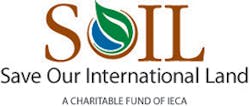The SOIL Fund, 2012 and Beyond
So, what’s next for the Save Our International Land (SOIL) Fund? Exciting things! We’d like to summarize the most recent happenings, so you can understand what a positive impact the SOIL Fund already is making and how much greater and far-reaching that impact can be with continued support and funding.
Chapter Challenge and Grants
IECA is expanding its efforts to seek funding from all sources (contributions, donations, fundraisers, etc.) to assist in funding SOIL Fund projects around the world. In addition, we will again use harassment and embarrassment to muster competition within our chapters to meet the recent Mid-Atlantic Chapter’s financial “challenge” to other IECA chapters to contribute or match its $1,000 donation to the SOIL Fund. Do any of the other chapters have the intestinal fortitude to stand up to (or exceed!) this challenge?
The SOIL Fund committee also will be looking to invest in the development of a SOIL Fund portfolio, which will identify the intent of the fund, identify our past and current project partners (such as Engineers Without Borders), outline some of the projects implemented and their outcomes, and present other submitted projects currently not funded. IECA will begin a process of exploring various grant opportunities and other financial partnerships to continue the valued work of IECA and its project partners in identifying, engineering, and completing SOIL Fund projects.
SOIL Fund in Ecuador
Our most recent SOIL Fund project was conducted by Will Mahoney, PG, CPSWQ, in conjunction with the Denver, Colorado, Professional Chapter of Engineers Without Borders (EWB). This project involved spending 12 days in Ecuador, including 10 days in the remote mountain community of Malingua Pamba (southwest of Ecuador’s capital, Quito), where Mahoney did an extensive survey of erosion problems associated with the area’s highly unstable volcanic soils. He found that erosion and sedimentation are threatening local potable and irrigation water systems, road connections to the rest of Ecuador, agricultural productivity, regional surface-water quality, and the aesthetic beauty of an area with great eco-tourism potential. He considered such potential low-tech solutions as planting native shrubs and grasses in eroded areas, lining gullies with gravel and cobbles, and protecting seeded areas with locally produced jute netting. He is in the process now of correlating his notes with some 500 photos and 100 GPS points in order to begin the daunting task of writing up his magnum opus report! This report will feed into the selection, design, and engineering of solutions for the problems in the area. These plans will be the focus of future joint SOIL Fund/EWB projects.
While there, Mahoney made a very interesting visit to another mountain community, Samil Pamba, with Jose Calvapino, an Ecuadorian agricultural engineer who is helping farmers with organic agriculture and very effective, low-tech terraces, which greatly mitigate soil erosion and increase soil productivity. During his last evening in Quito, he met with Jean Brown, a British ex-pat and specialist in tropical permaculture who has lived in Ecuador for 35 years and is very knowledgeable about the use of native plants to mitigate erosion. These connections may lead to new SOIL Fund projects and certainly to better techniques for the Malingua Pamba project.
Watch for Mahoney’s SOIL Fund presentation at EC12 in Las Vegas. It is sure to be a very picturesque, exciting, and moving talk about the ways and means to help others while furthering the science and art of erosion and sediment control.
– Phil Handley, REM, CPESC, CESSWI and Tom Williams, MA, CPESC


